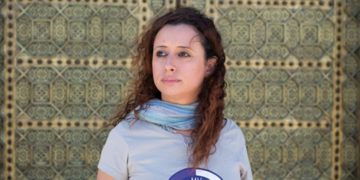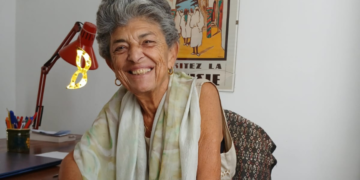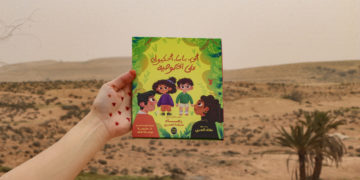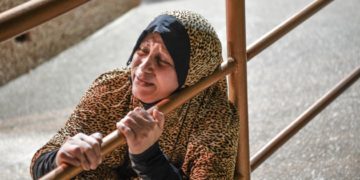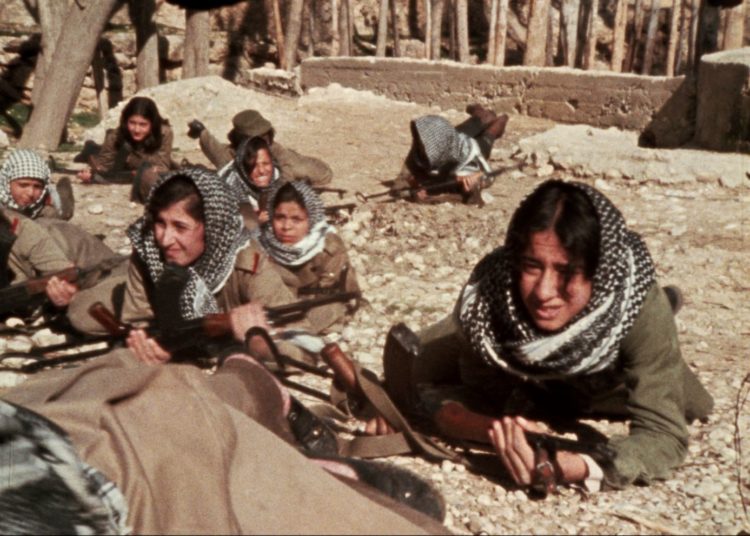This post is also available in: Français (French) العربية (Arabic)
Cover image: Sara al-Zoghbi sings with the Tajalli band in Alexandria – photo by Hossam Ezzat
In Afnan Shaher’s mind, the body is not just a skeleton, bones and flesh, but an entity pulsating with a hidden language, an entry into a spiritual gateway that opens only to those who dare to listen. She believes that the body, when left to its own devices, syncs with the rotations of the planets, the waves of the sea, and one’s own heartbeat. For her, dance is not a performance. It is a cosmic ritual, a journey toward the self in the silence of whirling.
That was the first seed that sprouted in Shaher’s mind, 31, when she stood on stage at Ain Shams University in 2015, performing the whirling dervish dance in a theatrical performance inspired by the novel The Forty Rules of Love by Turkish author Elif Shafak.
She decided to make “whirling” a lifestyle, not a passing performance. She continued to learn and practice it for two years after joining the Mashrou’ Rouh troupe in 2017, which blends Islamic supplications with Christian hymns.
People’s opinions varied. While some welcomed the performances and saw them as a break from male dominance, the majority considered them to be too much of a break from norms and traditions—women’s bodily movements being seen as haram, as impermissible.
People’s opinions varied. While some welcomed the performances and saw them as a break from male dominance, the majority considered them to be too much of a break from norms and traditions.

The first Egyptian all-female whirling troupe
At the time, Shaher had no idea that she was entering a world traditionally reserved for men. Speaking to Medfeminiswiya, she says, “When I started practicing whirling individually, I noticed that people were looking at me with extreme surprise. It was only then that I realized they believed that whirling was not permissible for women.”
The mawlawi dance is a Sufi ritual that originated with the followers of Jalal ad-Din Rumi in the 13th century in the Turkish city of Konya. It is not just a dance, but a physical prayer and movement of praise, a means of drawing closer to God and merging with Him.
Performed only by men, the dance begins with the dervish crossing his arms over his chest, symbolizing the oneness of God. He then opens them: the right arm toward the sky to receive blessings, the left toward the earth to spread them to the world. His eyes rest on his left palm, expressing the connection of the soul to the body.
By circling the heart, the dervish expresses the love for which humanity was created. As Rumi said, “All loves are a bridge to Divine love. Yet, those who have not had a taste of it do not know.”
For Shaher, the white clothes were not just a costume; they were a vision that resided within her, an idea pulsating in her imagination, an image of women gathered in their immaculate garments, whirling together in Sufi harmony, evoking a human galaxy in search of light. This was her initial inspiration, the first seed from which she decided to establish a women’s whirling troupe.
Shaher adds, “In my first experience with Sufi whirling, I felt my soul floating in the universe, among the stars and planets, freeing itself of all its burdens and returning to my body, safe and protected by God. That moment was an invitation for me to rediscover myself.”
At a pivotal moment, Shaher met Sara Kamel, a researcher in whirling science. Their visions converged, and together they founded Douri li-Tartaqi, the first Egyptian women’s whirling troupe. Soon, they were joined by other young women passionate about Sufi dancing, and under their supervision and training, the troupe’s core of seven members was formed.
In September 2023, Beit al-Sinnari (1), a palace built in 1789 the Sayyidah Zainab District, witnessed the first official appearance of the Douri troupe at the International Samaa Festival for Spiritual Music and Chanting (2). The audience saw the birth of a new entity, with women standing at the center of the circle, whirling not to dazzle the eye but to reveal hidden light.
The women of Douri in the realm of feminine Sufism
After Shaher became independent with the group, she expanded her project to include meditation and self-discovery sessions, bringing together body and soul in an experience where philosophy, art, and femininity intersect in a unique harmony.
The Douri group has become a safe space where women of varying ages and experiences can breathe, each rebuilding their relationship with themselves.

Girls and women arrive with questions they’ve been waiting to ask, broken dreams, and heavy hearts. With each whirl, old pain and pent-up energy are unleashed. Many seek not applause but a moment of inner silence, a reclaiming of the identity lost due to strict social roles.
“I didn’t set a limit for the number of members,” Shaher says. “I left the door open to any woman who wanted to explore her body with us, or relieve her burdens, by whirling.”
Accusations of kifr and atheism—for women only
As soon as the Douri troupe began performing, it faced a wave of sharp accusations of blasphemy. The criticism wasn’t directed at the performance or the artistic form, but at the presence of women in a spiritual space long dominated by men. The members were accused of violating tradition, despite wearing loose clothing that adheres to so-called “standards of modesty.” It was simply because they chose to spin not for beauty but to connect with something deeper.
Accusations escalated to conspiracy, with the troupe being described as a “Masonic front” seeking to corrupt women and distort Sufism. The attacks were not limited to criticism, either: there were personal insults and public scorn, as members and their families were targeted.
Shaher recalls that period, saying, “At first, the negative comments hurt me a lot, especially when the troupe had just launched. But I refused to give up. I turned the attacks into fuel to continue, to insist that souls cannot be separated into categories. No one has a monopoly over the whirl. Sufism is not the exclusive domain of men.”
Despite limited resources, the Douri troupe persists, relying entirely on self-financing. The members share the costs of costumes, training, and hall rental, in the absence of any institutional support. Regardless of the weight of the burden, they continue to strive to ensure the continuity of this unique art form.
Afnan Shaher sums up her dream in simple terms. “All I want is for the troupe, with its rehearsals and storytelling sessions, to remain a permanent haven for every woman seeking harmony with the movement of the universe.”







